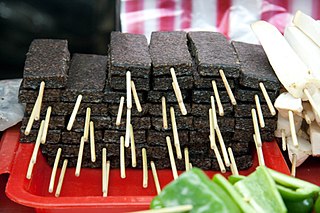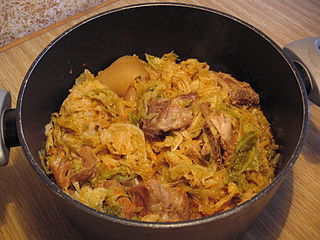
Mortadella is a large Italian sausage or luncheon meat made of finely hashed or ground heat-cured pork, which incorporates at least 15% small cubes of pork fat. It is traditionally flavoured with black pepper grains, but modern versions can also contain pistachios or, more rarely, myrtle berries.

A sausage is a type of meat product usually made from ground meat—often pork, beef, or poultry—along with salt, spices and other flavourings. Other ingredients, such as grains or breadcrumbs may be included as fillers or extenders.

Head cheese or brawn is a cold cut terrine or meat jelly that originated in Europe. However it is popular in the United States among the African-American and white population. In southern Louisiana, hog's head cheese is a specialty that used to be a deli and butcher shop staple. It is made with flesh from the head of a calf or pig, typically set in aspic, and usually eaten cold, at room temperature, or in a sandwich. Despite its name the dish is not a cheese and contains no dairy products. The parts of the head used vary, and may include the tongue and sometimes the feet and heart but do not commonly include the brain, eyes or ears. Trimmings from more commonly eaten cuts of pork and veal are often used, with gelatin added as a binder.

Hungarian or Magyar cuisine is the cuisine characteristic of the nation of Hungary and its primary ethnic group, the Magyars. Traditional Hungarian dishes are primarily based on meats, seasonal vegetables, fruits, bread, and dairy products.

Salami is a cured sausage consisting of fermented and air-dried meat, typically pork. Historically, salami was popular among Southern, Eastern, and Central European peasants because it can be stored at room temperature for up to 40 days once cut, supplementing a potentially meager or inconsistent supply of fresh meat. Countries and regions across Europe make their own traditional varieties of salami.

Chorizo is a type of pork sausage originating from the Iberian Peninsula.

Szeged is the third largest city of Hungary, the largest city and regional centre of the Southern Great Plain and the county seat of Csongrád-Csanád county. The University of Szeged is one of the most distinguished universities in Hungary.

Aspic or meat jelly is a savoury gelatin made with a meat stock or broth, set in a mold to encase other ingredients. These often include pieces of meat, seafood, vegetable, or eggs. Aspic is also sometimes referred to as aspic gelée or aspic jelly. In its simplest form, aspic is essentially a gelatinous version of conventional soup.

A cabbage roll is a dish consisting of cooked cabbage leaves wrapped around a variety of fillings. It is common to the cuisines of Central, Northern, Eastern and Southeastern Europe and much of Western Asia, Northern China, as well as parts of North Africa. Meat fillings are traditional in Europe, and include beef, lamb, or pork seasoned with garlic, onion, and spices. Grains such as rice and barley, mushrooms, and vegetables are often included as well. Fermented cabbage leaves are used for wrapping, particularly in southeastern Europe. In Asia, seafoods, tofu, and shiitake mushrooms may also be used. Chinese cabbage is often used as a wrapping.
Romanian cuisine is a diverse blend of different dishes from several traditions with which it has come into contact, but it also maintains its own character. It has been mainly influenced by Turkish and a series of European cuisines in particular from the Balkans, or Hungarian cuisine as well as culinary elements stemming from the cuisines of Eastern and Central Europe.

Kishka or kishke refers to various types of sausage or stuffed intestine with a filling made from a combination of meat and meal, often a grain. The dish is popular across Eastern Europe as well as with immigrant communities from those areas. It is also eaten by Ashkenazi Jews who prepare their version according to kashrut dietary laws.

Hungarian sausages are sausages found in the cuisine of Hungary. Hungary produces a vast number of sausage types. They may be boiled, fresh or dried, and smoked, with different spices and flavors, "hot" or "mild". Many were influenced by their neighbors and brethren.

Many cultures consume blood as food, often in combination with meat. The blood may be in the form of blood sausage, as a thickener for sauces, a cured salted form for times of food scarcity, or in a blood soup. This is a product from domesticated animals, obtained at a place and time where the blood can run into a container and be swiftly consumed or processed. In many cultures, the animal is slaughtered. In some cultures, blood is a taboo food.

Winter salami is a type of Hungarian salami produced according to a centuries-old tradition. Made from Mangalitsa pork and spices, winter salami is cured in cold air and smoked slowly. During the dry ripening process, a special noble-mold is formed on the casing surface.

Because of the different historical events of its provinces and of the diversity of its territories, Lombard cuisine presents a very varied culinary tradition: for first courses the Lombard cuisine ranges from risottos to soups and stuffed pasta, in broth or not, a varied choice of second courses meat dishes are added to fish dishes of the tradition of the many lakes and rivers of Lombardy.
Sibiu Salami, also known as Salam de Sibiu, is a Romanian variety of salami made with pork meat, pork fat, salt and condiments. In 2016, the Salam de Sibiu has been registered as a protected geographical indication (PGI) product in the European Union.

Salame Felino is a variety of Italian salame historically produced in the municipality of Felino and in some neighboring municipalities, such as Sala Baganza and Langhirano, all in the province of Parma. Having obtained the European certification of "Protected Geographical Indication", this salami is protected from counterfeiting.













